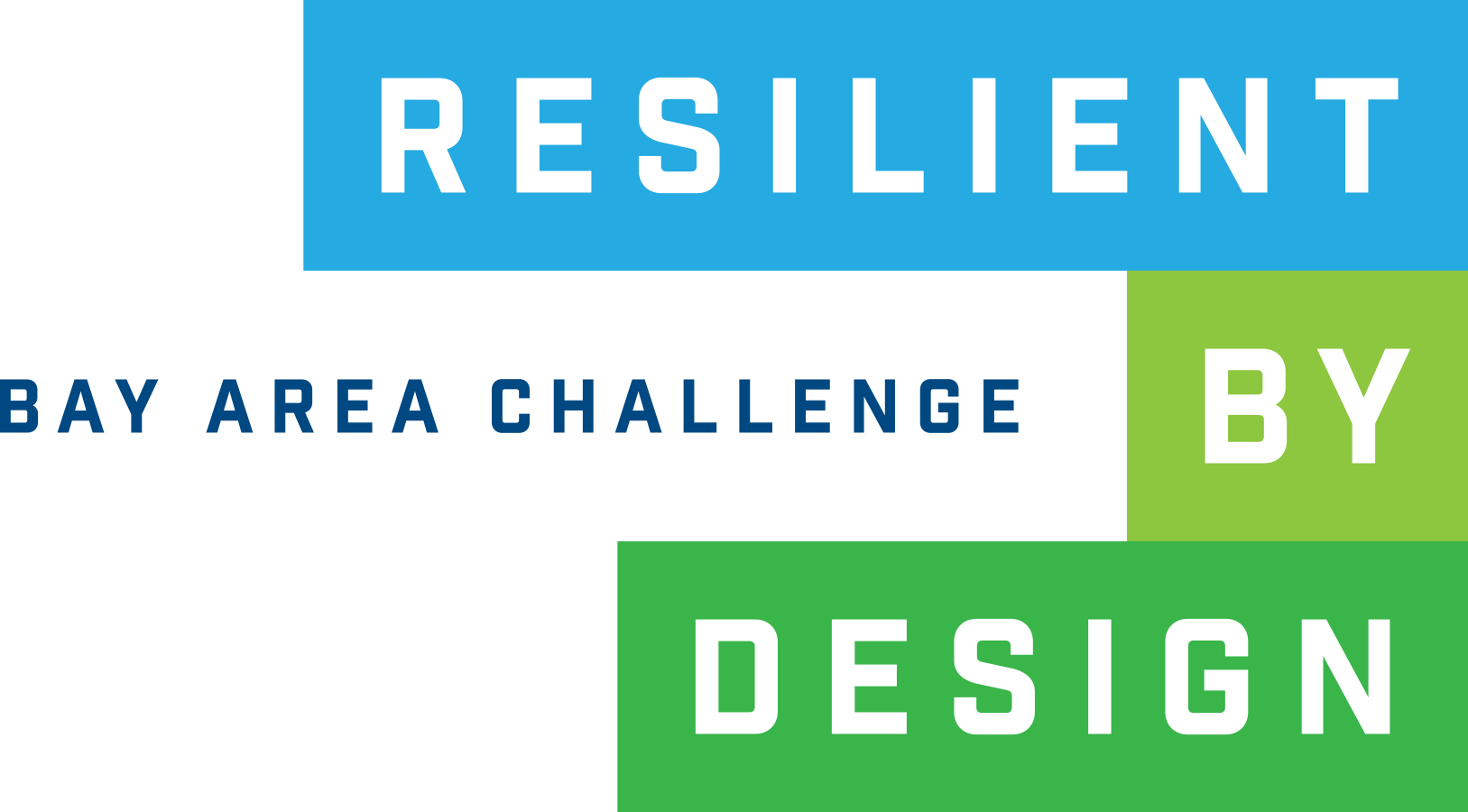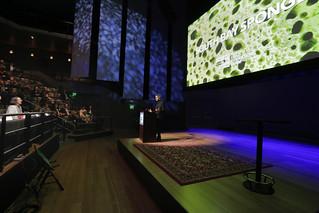Rather than wait for a natural disaster, the San Francisco Bay Area is proactively reimagining a better future by creating a blueprint for resilience that harnesses Bay Area innovation and serves as a model for communities around the world.
The premise of the Resilient by Design Bay Area Challenge (RbD) was both simple and audacious. As flood risks increase due to intensified severe storms and sea level rise, organizers asked the question - can the Bay Area come together to shift its course and build a more resilient region before a big disaster hits, and can we address other regional challenges along the way?
The exchange of knowledge, relationships built, and ideas generated by the Resilient by Design | Bay Area Challenge have inspired, activated, and informed individuals and institutions throughout the region to take seriously the threat of climate change. The regional momentum generated will continue on as communities work together to build resilience, implement Resilient by Design projects and address sea level rise and climate change impacts around San Francisco Bay. However, we know that to take on such an enormous challenge the work is just beginning.
In 2016, the Bay Area passed a groundbreaking ballot initiative to generate hundreds of millions of dollars for wetland and habitat restoration, flood control and public access along the shoreline. Over 70% of Bay Area voters voted in favor of the Clean Water, Pollution Prevention and Habitat Restoration Measure (or Measure AA) to tax themselves in order to contribute to the health and preservation of San Francisco Bay. Communities in the Bay Area were willing to proactively invest to preserve our natural assets for future generations.
Parallel to this effort, a group of forward thinking regional leaders had been working since 2015 to develop a plan for a proactive regional design challenge modeled after Rebuild by Design. The resilience plans developed in San Francisco, Oakland and Berkeley as part of the Rockefeller Foundation’s 100 Resilient Cities effort identified a need for greater regional collaboration to address climate adaptation - despite the looming threat of climate change, there was no comprehensive regional plan to deal with the sea level in the Bay Area. The unique hydrology of the Bay warranted the type of collaboration the design challenge could facilitate, as shoreline protections in one area of the Bay could increase sea levels or wave action in another. Collaboration on this scale could help illuminate the need for each county to consider the impacts of their decisions on the other communities that share the shoreline. With hundreds of jurisdictions and countless communities sharing the shoreline, there was ample need to catalyze and inspire collaboration.
The commitment of regional leaders to an innovative, proactive climate adaptation design challenge along with the willingness of Bay Area voters to proactively fund San Francisco Bay restoration inspired the Rockefeller Foundation to provide a foundational grant to launch the Resilient by Design | Bay Area Challenge in early 2017.
THE PROCESS
The LauncH Phase
The premise of the Resilient by Design Bay Area Challenge was to connect internationally-renowned experts with local communities to inspire innovation and catalyze designs, ideas and collaboration toward a more resilient future. To achieve that, the Challenge launched on May 31, 2017 with an open call for Design Teams to participate in the challenge and an open call for site ideas - which asked community members, government staff and regional experts to identify places around the Bay that are vulnerable to flood risk and that could benefit from a collaborative, multi-benefit, multi-disciplinary design process.
Public Call for Vulnerable Sites
Over the next year, residents and local leaders will partner with local, national and international experts from the design community – architects, engineers, designers, planners and more - to develop innovative solutions that build our region’s resilience to threats like sea level rise, severe storms, flooding and earthquakes while also addressing critical issues such as disparities in housing, income, access to open space, and environmental justice.
To make this initiative successful we need you to help us to identify the Bay Area’s most vulnerable ecological systems and most vulnerable bayfront communities, as well as our outdated infrastructure at risk from a natural disaster. We're looking for challenging areas with strong community engagement that could benefit from the creative, innovative energy from a multi-disciplinary design team partnering with local leaders to come up with implementable solutions.
Design Team Selection
The Bay Area Challenge Design Brief issued a call to form teams up to the task of building multi-faceted solutions to flooding challenges in the Bay exacerbated by severe storms, groundwater inundation and sea level rise. Over 50 teams from across the region and the world applied to enter the challenge.
Resilient by Design Kick Off
In September of 2017, the Jury announced the 10 teams selected to a crowd of hundreds at a kick off event overlooking San Francisco Bay along the Richmond shoreline. The Design Team members represented significant local talent as well as representatives from all over the US and around the world. Over 90 organizations and firms were represented on teams, bringing decades of experience creating innovative and effective nature based solutions to reduce flood risk, enhance local communities and address some of the biggest challenges facing our region. Each team brought their own unique set of experiences and technical expertise to the challenge. Some teams came with a deep knowledge of the Bay Area, while others drew primarily on national or international experience. Water managers and engineers from places as far as the Netherlands and Australia would work alongside designers and community organizers from across the region.
At the event, local elected officials, community organizations, planning agencies and others assembled to launch the challenge and build connections with one another. Design Teams mingled and met with community leaders, and began to get a sense of the cohort of experts they would work with in the months to come.
“The Bay Area has always been on the forefront of leading change and now has the collective opportunity to take a true next step. Not only will the Challenge bring about 10 new approaches to serve as blueprints for the region, but it can also connect the community long-term to the idea of resilience. We are proud to stand with the other Bay Area communities who join Richmond in making this a priority.”
COLLABORATIVE RESEARCH Phase
Building resilience requires a different kind of thinking. Often the goal in addressing big challenges is to narrow the scope of an issue enough to find a discrete solution. In this challenge however, Design Teams were asked to expand the scope of sea level rise beyond flood mitigation. The Collaborative Research Phase allowed Design Teams to learn about the unique assets and challenges in the Bay before making assumptions about the problems they should be solving for. The five month program familiarized Design Teams with the Bay Area’s unique regional context and built a shared understanding of communities and ecosystems in the bay. New connections were forged between practitioners and experts across fields as teams engaged in tours, discussions, and talks led by Bay Area experts and community leaders. Teams grappled with issues from wetland loss and sediment flow, to housing access and wastewater treatment.
The tour weeks were guided by Resilient by Design guiding principles and planned in partnership with dozens of organizations and agencies. This phase gave the designers a stronger foundation to assess multi-dimensional problems as they moved into the design phase.
GUIDING PRINCIPLES
As a foundation for the Bay Area Challenge, Resilient by Design developed the following guiding principles. These principles were used to help shape the research tours and events in fall 2017. In the Collaborative Design Phase, Design Teams utilized these guiding principles to assist in the development of their workplans and engagement tools with the goal of fostering an inclusive, equitable and collaborative design process.
1. Address multifaceted, dynamic issues through collaboration, coordination and connection.
2. Prepare vulnerable communities for a resilient future by addressing our shared history, ecological, economic, and social vulnerabilities that still exist today.
3. Integrate social and ecological systems through rigorous research and a strong understanding of ecosystems, local community, and government challenges.
4. Integrate principles to sustain biodiversity and ecological functions.
5. Merge local, regional, and international knowledge with technical expertise toward implementable and creative design-driven ideas.
6. Acknowledge place and the First Nations of the Bay Area.
7. Develop equitable planning and development practices where community members are true collaborators and participate as equal partners at every level of design formation.
8. Leverage community knowledge and integrate in design to improve and not displace community members.
Presenting Design Opportunities
At the close of the Collaborative Research Phase, Design Teams presented their initial ideas to the Research Advisory Committee and stakeholders at a public reception at the Contemporary Jewish Museum in downtown San Francisco. The ideas generated ranged from more traditional restoration efforts integrated into larger regional context, to novel and ambitious plans for floating housing stock and transformative regional initiatives.
After the presentations, the Research Advisory Committee evaluated the research and designs produced by each of the teams. Committee members also reviewed and weighed stakeholder and public input on each of the potential project ideas. The advisory committee then matched each team with one potential project location to develop alongside community stakeholders in the Collaborative Design Phase.
In order to get public feedback on the Design Opportunities and ground truth the ideas as part of the matching process, Resilient by Design partnered with Neighborland to create an online communication platform. Since not everyone has the ability or interest in attending a public event, this online tool was a great way to get local related to proposals around the Bay Area.Local experts were able to log online and comment directly on the renderings, sketches and text about each Design Opportunity. This information was used by the research advisors in selecting one of the Design Opportunities for each team.
“We came to this challenge as a team of technical and academic experts. We leave as committed allies in community-driven planning, enriched by our collaboration with neighborhood and agency representatives. We see the San Leandro Bay Estuary representing the dawn of a new era in city-making – an era when community priorities are at the heart of important decisions and residents prosper in harmony with rising water levels.”
COLLABORATIVE DESIGN PHASE
The Collaborative Design phase kicked off in January 2018, with community meetings and the formation of local advisory groups in each project area. This phase was an opportunity for designers to dive deeper into site-specific challenges, and co-create solutions with local jurisdictions and communities. Through outreach events, community meetings, and creative engagement tactics, Design Teams learned from communities and shared their own expertise. Advisory groups in each county included relevant stakeholders such as local elected officials and city staff, regional park and open space districts, environmental justice leaders, flood managers, ecologists, community members, and advocacy organizations.
FINAL DESIGNS
In May of 2018, at the close of the collaborative design phase, each team presented their final designs to the Resilient by Design Jury and the public at a day long event at the SF Jazz Center. Each team presented alongside the local stakeholders and community leaders who had been engaged in the Collaborative Design Phase.






